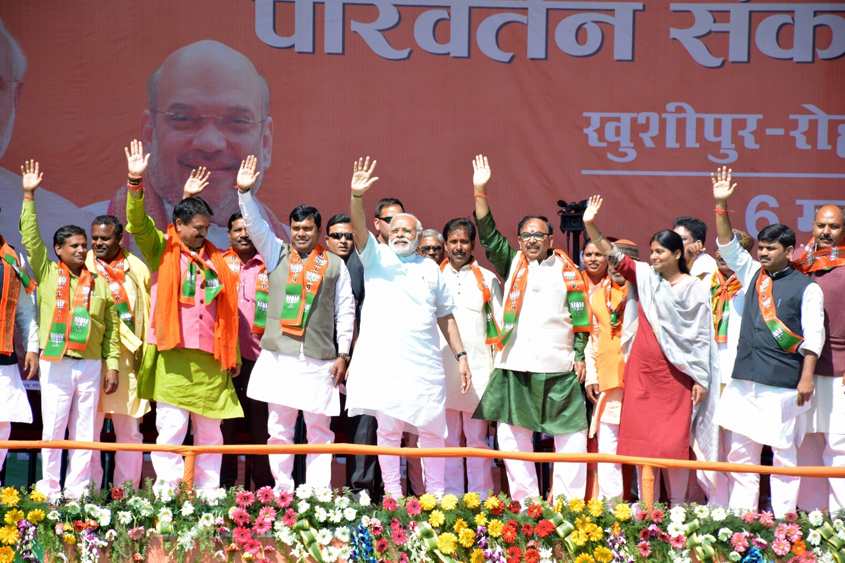By propelling the Bharatiya Janata Party to an incredible but impressive victory in the country’s most populous state of Uttar Pradesh, Prime Minister Narendra Modi has established himself as the undisputed leader of India. The win also set to rest all doubts about his ability to lead from the front and ended speculation about his diminishing popularity since the 2014 historic verdict in the Parliamentary elections.
The palpably pronounced outcome in Uttar Pradesh sent the entire Opposition reeling for cover and paved the way for the Prime Minister to go ahead with his agenda for launching the requisite steps to escalate the growth rate of the economy. It is perceptible that Modi’s initiatives of demonetisation, providing gas cylinders to 75 lakh households and support against triple talaq touched a chord amongst women voters in particular, thereby contributing to the final result. Though there is no evidence to support the claim as yet, it is possible that young Muslim women perhaps also tilted towards the BJP in this politically surcharged and highly divisive and polarised election.
On another note, his pro poor measures helped in giving the contest class overtones. It perhaps provided early indications that Modi politics may get a shade of leftist dimensions to portray the Prime Minister as the messiah of the downtrodden and weaker sections in the same unmistakable manner it had helped Indira Gandhi to attain unprecedented popularity in the wake of the Garibi Hatao campaign in the early 1970s.
The verdict has placed Modi in the driver’s seat, providing him an iconic status as well as enabling him to choose the Presidential nominee of his liking for the elections to decide who would succeed Pranab Mukherjee in the Rashtrapati Bhawan in July this year. The massive mandate would further allow the Prime Minister and his party to subsequently acquire a majority in the Rajya Sabha, thus facilitating the BJP’s complete control over the two Houses of Parliament.
The victory in Uttar Pradesh, along with a good showing in Uttarakhand, has reinforced the belief that it was never going to be easy to beat him in any election, particularly because of his aggressive but well focused campaign style. Simultaneously, Modi has asserted his complete supremacy in the Sangh Parivar, where conspiracies had already started taking root to weaken him, and several of his opponents, choosing to operate in a clandestine manner, were plotting to challenge his leadership in case the BJP was unable to win Uttar Pradesh.
Charged with the overwhelming support he has received from the masses, the Prime Minister could carry out changes in the composition of the Parliamentary Board of the party, so as to include his preferred nominees, while at the same time bring about a major reshuffle in the Union Cabinet in order to ease out the deadwood. The result could possibly define the new terms of engagement, with the Rashtriya Swayamsevak Sangh giving him a greater say in matters of mutual interest. The Uttar Pradesh poll result has also surpassed the BJP’s best ever performance there in 1991, when it won 221 seats in the undivided state, soon after L.K. Advani made Ayodhya and the construction of a Ram temple to be the pivotal issue to counter the Mandalisation of Indian politics by the Vishwanath Pratap Singh government in August, 1990.
The entire campaign has a lesson for both his rivals and his supporters, since it underlines the need to have a well thought through political strategy. It is obvious that the Prime Minister was the only one who was working to a plan to further the chances of his party’s nominees as well as to make his opponents fall into well laid out traps. Modi is, without any question, the most symbolic idol of Hindutva forces and by attempting to counter him by seeking votes from minority communities, his opponents ended up helping the BJP to consolidate the majority vote share.
There was never any endeavour by him and the BJP president to conceal their commitment to Hindutva as against the over emphasis by others to play out the minority card. Images of the Prime Minister giving fodder to cows and going to the Kashi Vishwanath temple to seek blessings were apparently well received by the electorate and worked as his trump card in a state where religion has always been paramount for the people.
To counter the Samajwadi Party-Congress blueprint to make it appear as a generational change poll, Modi continued to ridicule his opponents for showing utter disregard to elders as demonstrated by Akhilesh Yadav’s act of marginalising his father and Rahul Gandhi not paying any heed to his mother. Mayawati’s attempt to claim the Muslim votes by declaring support from the Muslim clergy repeatedly, contributed in helping the BJP to consolidate the Hindu vote, which, despite moderate polling in Uttar Pradesh, proved, in the end, crucial.
The UP election was regarded as a two-leg semi final for Modi (the second leg being that of Gujarat Assembly polls later this year) prior to the 2019 Parliamentary polls. It is conspicuously clear that for the time being there is no challenge left and the Opposition parties have to realise that it was not enough to forge alliances, unless there was a clear cut strategy to combat Modi. The future confrontation will have to be on good governance and development fronts, since playing the minority formula would only wield more power to the BJP and make its Prime Minister stronger.

